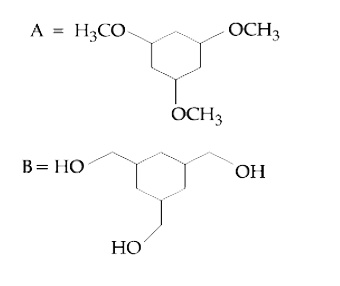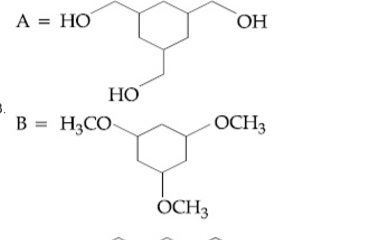There are two compounds A and B of molecular formula C9H18O3. A has higher boiling point than B. What are the possible structures of A and B?




The correct Answer is:C
To determine the possible structures of compounds A and B with the molecular formula C9H18O3, where A has a higher boiling point than B, we need to consider the factors that influence boiling points, particularly the type of intermolecular forces present in each compound.
1. Understanding the Molecular Formula:
- Both compounds A and B have the same molecular formula C9H18O3. This means they contain the same number of carbon, hydrogen, and oxygen atoms, but their structural arrangements can differ.
2. Identifying Intermolecular Forces:
- The boiling point of a substance is influenced by the strength of its intermolecular forces. Stronger intermolecular forces lead to higher boiling points.
- The primary types of intermolecular forces are hydrogen bonding, dipole-dipole interactions, and London dispersion forces. Hydrogen bonding is the strongest among these.
3. Analyzing the Compounds:
- To have a higher boiling point, compound A should have stronger intermolecular forces compared to compound B. This can be achieved if A has more hydroxyl (-OH) groups (alcohols) compared to B, as alcohols can form hydrogen bonds.
4. Considering Possible Structures:
- Let's consider the possible structures for A and B:
- Option 1: A has 1 alcohol and 2 ethers; B has 2 alcohols and 1 ether.
- Option 2: A has 3 alcohols; B has 0 alcohols (3 ethers).
- Option 3: A has 3 ethers; B has 3 alcohols.
- Option 4: A has 2 alcohols and 1 ether; B has 1 alcohol and 2 ethers.
5. Evaluating Each Option:
- Option 1: B has more alcohols than A, so B would have a higher boiling point. (Not valid)
- Option 2: A has 3 alcohols and B has none, which means A would have a significantly higher boiling point due to hydrogen bonding. (Valid)
- Option 3: A has 3 ethers and B has 3 alcohols, so B would have a higher boiling point. (Not valid)
- Option 4: A has 2 alcohols and B has 1 alcohol, so A would have a higher boiling point, but not as high as in Option 2. (Not the best option)
6. Conclusion:
- The best option is Option 2, where compound A has 3 alcohol groups and compound B has 0 alcohol groups (3 ethers). This configuration allows A to have a significantly higher boiling point due to the presence of hydrogen bonding.
Final Structures:
- Compound A: A structure with 3 hydroxyl (-OH) groups (alcohol).
- Compound B: A structure with 3 ether groups.
- Both compounds A and B have the same molecular formula C9H18O3. This means they contain the same number of carbon, hydrogen, and oxygen atoms, but their structural arrangements can differ.
- The boiling point of a substance is influenced by the strength of its intermolecular forces. Stronger intermolecular forces lead to higher boiling points.
- The primary types of intermolecular forces are hydrogen bonding, dipole-dipole interactions, and London dispersion forces. Hydrogen bonding is the strongest among these.
- To have a higher boiling point, compound A should have stronger intermolecular forces compared to compound B. This can be achieved if A has more hydroxyl (-OH) groups (alcohols) compared to B, as alcohols can form hydrogen bonds.
- Let's consider the possible structures for A and B:
- Option 1: A has 1 alcohol and 2 ethers; B has 2 alcohols and 1 ether.
- Option 2: A has 3 alcohols; B has 0 alcohols (3 ethers).
- Option 3: A has 3 ethers; B has 3 alcohols.
- Option 4: A has 2 alcohols and 1 ether; B has 1 alcohol and 2 ethers.
- Option 1: B has more alcohols than A, so B would have a higher boiling point. (Not valid)
- Option 2: A has 3 alcohols and B has none, which means A would have a significantly higher boiling point due to hydrogen bonding. (Valid)
- Option 3: A has 3 ethers and B has 3 alcohols, so B would have a higher boiling point. (Not valid)
- Option 4: A has 2 alcohols and B has 1 alcohol, so A would have a higher boiling point, but not as high as in Option 2. (Not the best option)
- The best option is Option 2, where compound A has 3 alcohol groups and compound B has 0 alcohol groups (3 ethers). This configuration allows A to have a significantly higher boiling point due to the presence of hydrogen bonding.
- Compound A: A structure with 3 hydroxyl (-OH) groups (alcohol).
- Compound B: A structure with 3 ether groups.
Topper's Solved these Questions
Similar Questions
Knowledge Check
An aromatic compound A of the molecular formula C8H10O on reaction with iodine and dilute NaOH gives a yellow precipitate. The structure of the compound is expected to be :
A BC6H5CHOHCH3C
BC6H5CHOHCH3C D
D
A compound (A) has molecular formula C5H9Cl .It does not react with bromine in CCl4. On treatment with a strong base it produces a single compound (B), (B) has a molecular formula C5H8 and reacts with Baeyer's reagent . Reductive ozonolysis of (B) produces a compound (C ) which has a molecular formula C5H8O2
On the basis of the given data what would be the structure of A ?
View SolutionThe number of metamers of the compound with molecular formula C5H12O is/are:
View SolutionThe structure of the compound with molecular formula C6H12 that has only 2∘ H atoms is:
View SolutionAssertion : O3 has higher boiling point than O2.
Reason : O3 is allotrope of oxygen.
View SolutionThe structure of the compound with molecular formula C8H14 that has 12 secondary and 2 tertiary H atoms is:
View SolutionA hydrocarbon C9H10(A) rapidly decolourises cold aquous permanganate and rapidly absorts one molecule of bromine . Vigous hydrogenation of (A) gives a compound (A) gives a compound (B) of the formula C9H18. Strong oxidation of (A) yileds phyalic acid. Propose a structure for (A) and give the basic for your answer.
View SolutionAn organic compound has molecular formula C9H18. It is a saturated hydrocarbon and its all hydrogen atoms are identical. Its structural formula can be :
View Solution
